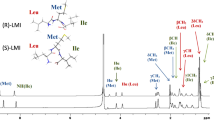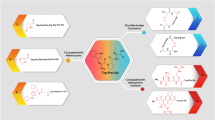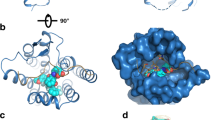Abstract
The corticotrophin-releasing factor (CRF) and its type 1 receptor (CRF1R) regulate the hypothalamic-pituitary-adrenal axis, as well as other systems, thus playing a crucial role in the maintenance of homeostasis. Non-peptide CRF1R-selective antagonists exert therapeutic effects on experimental animals with abnormal regulation of their homeostatic mechanisms. However, none of them is as yet in clinical use. In an effort to develop novel small non-peptide CRF1R-selective antagonists, we have synthesized a series of substituted pyrimidines described in a previous study. These small molecules bind to CRF1R, with analog 3 having the highest affinity. Characteristic structural features of analog 3 are a N,N-bis(methoxyethyl)amino group at position 6 and a methyl in the alkythiol group at position 5. Based on the binding profile of analog 3, we selected it in the present study for further pharmacological characterization. The results of this study suggest that analog 3 is a potent CRF1R-selective antagonist, blocking the ability of sauvagine, a CRF-related peptide, to stimulate cAMP accumulation in HEK 293 cells via activation of CRF1R, but not via CRF2R. Moreover, analog 3 blocked sauvagine to stimulate the proliferation of macrophages, further supporting its antagonistic properties. We have also constructed molecular models of CRF1R to examine the interactions of this receptor with analog 3 and antalarmin, a prototype CRF1R-selective non-peptide antagonist, which lacks the characteristic structural features of analog 3. Our data facilitate the design of novel non-peptide CRF1R antagonists for clinical use.






Similar content being viewed by others
References
Vale W, Spiess J, Rivier C, Rivier J (1981) Characterization of a 41-residue ovine hypothalamic peptide that stimulates secretion of corticotropin and beta-endorphin. Science 213(4514):1394–1397
Owens MJ, Nemeroff CB (1991) Physiology and pharmacology of corticotropin-releasing factor. Pharmacol Rev 43(4):425–473
Ramot A, Jiang Z, Tian JB et al (2017) Hypothalamic CRFR1 is essential for HPA axis regulation following chronic stress. Nat Neurosci 20(3):385–388
Chrousos GP (2009) Stress and disorders of the stress system. Nat Rev Endocrinol 5(7):374–381
Chrousos GP (1995) The hypothalamic-pituitary-adrenal axis and immune-mediated inflammation. N Engl J Med 332(20):1351–1362
Martinez V, Tache Y (2006) CRF1 receptors as a therapeutic target for irritable bowel syndrome. Curr Pharm Des 12(31):4071–4088
Venihaki M, Majzoub J (2002) Lessons from CRH knockout mice. Neuropeptides 36(2–3):96–102
Slominski AT, Zmijewski MA, Zbytek B et al (2013) Key role of CRF in the skin stress response system. Endocr Rev 34(6):827–884
Dermitzaki E, Liapakis G, Androulidaki A et al (2014) Corticotrophin-releasing factor (CRF) and the urocortins are potent regulators of the inflammatory phenotype of human and mouse white adipocytes and the differentiation of mouse 3T3L1 pre-adipocytes. PLoS One 9(5):e97060
Karalis K, Sano H, Redwine J et al (1991) Autocrine or paracrine inflammatory actions of corticotropin-releasing hormone in vivo. Science 254(5030):421–423
Henckens MJ, Deussing JM, Chen A (2016) Region-specific roles of the corticotropin-releasing factor-urocortin system in stress. Nat Rev Neurosci 17(10):636–651
Arborelius L, Owens MJ, Plotsky PM, Nemeroff CB (1999) The role of corticotropin-releasing factor in depression and anxiety disorders. J Endocrinol 160(1):1–12
Reul JM, Holsboer F (2002) Corticotropin-releasing factor receptors 1 and 2 in anxiety and depression. Curr Opin Pharmacol 2(1):23–33
Nielsen DM (2006) Corticotropin-releasing factor type-1 receptor antagonists: the next class of antidepressants? Life Sci 78(9):909–919
Rivier JE, Rivier CL (2014) Corticotropin-releasing factor peptide antagonists: design, characterization and potential clinical relevance. Front Neuroendocrinol 35(2):161–170
Grammatopoulos DK, Chrousos GP (2002) Functional characteristics of CRH receptors and potential clinical applications of CRH-receptor antagonists. Trends Endocrinol Metab 13(10):436–444
Shaham Y, de Wit H (2016) Lost in translation: CRF1 receptor antagonists and addiction treatment. Neuropsychopharmacology 41(12):2795–2797
Spierling SR, Zorrilla EP (2017) Don't stress about CRF: assessing the translational failures of CRF1antagonists. Psychopharmacology 234(9–10):1467–1481
Muller MB, Zimmermann S, Sillaber I et al (2003) Limbic corticotropin-releasing hormone receptor 1 mediates anxiety-related behavior and hormonal adaptation to stress. Nat Neurosci 6(10):1100–1107
Timpl P, Spanagel R, Sillaber I et al (1998) Impaired stress response and reduced anxiety in mice lacking a functional corticotropin-releasing hormone receptor 1. Nat Genet 19(2):162–166
Zorrilla EP, Koob GF (2010) Progress in corticotropin-releasing factor-1 antagonist development. Drug Discov Today 15(9–10):371–383
Fahmy H, Spyridaki K, Kuppast B, Liapakis G (2012) The "homeostasis hormone" and its CRF(1) receptor. From structure to function. Hormones (Athens) 11(3):254–271
Stengel A, Goebel M, Million M et al (2009) Corticotropin-releasing factor-overexpressing mice exhibit reduced neuronal activation in the arcuate nucleus and food intake in response to fasting. Endocrinology 150(1):153–160
Liapakis G, Venihaki M, Margioris A, Grigoriadis D, Gkountelias K (2011) Members of CRF family and their receptors: from past to future. Curr Med Chem 18(17):2583–2600
Hillhouse EW, Grammatopoulos DK (2006) The molecular mechanisms underlying the regulation of the biological activity of corticotropin-releasing hormone receptors: implications for physiology and pathophysiology. Endocr Rev 27(3):260–286
Gkountelias K, Papadokostaki M, Javitch JA, Liapakis G (2010) Exploring the binding site crevice of a family B G protein-coupled receptor, the type 1 corticotropin releasing factor receptor. Mol Pharmacol 78(4):785–793
Grace CR, Perrin MH, DiGruccio MR et al (2004) NMR structure and peptide hormone binding site of the first extracellular domain of a type B1 G protein-coupled receptor. Proc Natl Acad Sci U S A 101(35):12836–12841
Pioszak AA, Parker NR, Suino-Powell K, Xu HE (2008) Molecular recognition of corticotropin-releasing factor by its G-protein-coupled receptor CRFR1. J Biol Chem 283(47):32900–32912
Hoare SR, Sullivan SK, Ling N, Crowe PD, Grigoriadis DE (2003) Mechanism of corticotropin-releasing factor type I receptor regulation by nonpeptide antagonists. Mol Pharmacol 63(3):751–765
Kuppast B, Spyridaki K, Liapakis G, Fahmy H (2014) Synthesis of substituted pyrimidines as corticotropin releasing factor (CRF) receptor ligands. Eur J Med Chem 78:1–9
Venihaki M, Gravanis A, Margioris AN (1996) Kappa opioids exert a strong antiproliferative effect on PC12 rat pheochromocytoma cells. Peptides 17(3):413–419
Hollenstein K, Kean J, Bortolato A et al (2013) Structure of class B GPCR corticotropin-releasing factor receptor 1. Nature 499(7459):438–443
Trott O, Olson AJ (2010) AutoDock Vina: improving the speed and accuracy of docking with a new scoring function, efficient optimization, and multithreading. J Comput Chem 31(2):455–461
Wootten D, Simms J, Miller LJ, Christopoulos A, Sexton PM (2013) Polar transmembrane interactions drive formation of ligand-specific and signal pathway-biased family B G protein-coupled receptor conformations. Proc Natl Acad Sci U S A 110(13):5211–5216
Spyridaki K, Matsoukas MT, Cordomi A et al (2014) Structural-functional analysis of the third transmembrane domain of the Corticotropin-releasing factor type 1 receptor: Role in activation and allosteric antagonism. J Biol Chem 289(27):18966–18977
Cordomi A, Liapakis G, Matsoukas MT (2017) Understanding Corticotropin releasing factor receptor (CRFR) activation using structural models. Curr Mol Pharmacol 10(4):325–333
McGillis JP, Park A, Rubin-Fletter P et al (1989) Stimulation of rat B-lymphocyte proliferation by corticotropin- releasing factor. J.Neurosci.Res. 23(3):346–352
Singh VK (1989) Stimulatory effect of corticotropin-releasing neurohormone on human lymphocyte proliferation and interleukin-2 receptor expression. J Neuroimmunol 23:257–262
Jessop DS, Harbuz MS, Snelson CL, Dayan CM, Lightman SL (1997) An antisense oligodeoxynucleotide complementary to corticotropin- releasing hormone mRNA inhibits rat splenocyte proliferation in vitro. J.Neuroimmunol. 75(1–2):135–140
Author information
Authors and Affiliations
Corresponding author
Ethics declarations
Conflict of interest
The authors declare that they have no conflicts of interest.
Grants or fellowship supports
This work was supported by ELKE grant K.A. 4373 (George Liapakis) and ELKE grant K.A. 3330 (Andrew Margioris).
Additional information
Publisher’s note
Springer Nature remains neutral with regard to jurisdictional claims in published maps and institutional affiliations.
Rights and permissions
About this article
Cite this article
Sakellaris, S., Matsoukas, MT., Karageorgos, V. et al. Selective antagonism of CRF1 receptor by a substituted pyrimidine. Hormones 18, 215–221 (2019). https://doi.org/10.1007/s42000-019-00105-9
Received:
Accepted:
Published:
Issue Date:
DOI: https://doi.org/10.1007/s42000-019-00105-9




